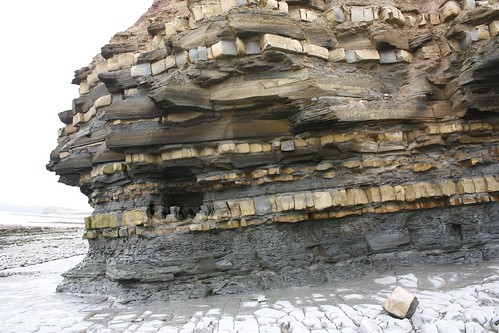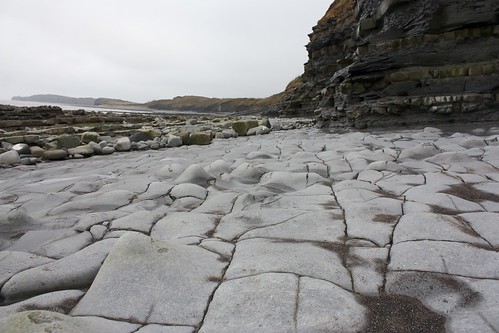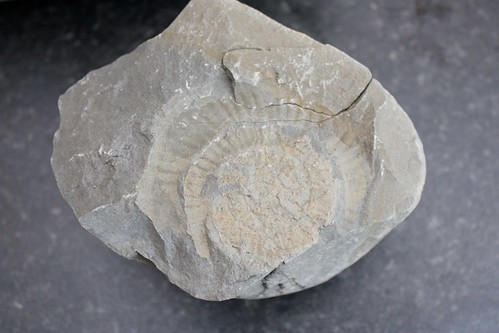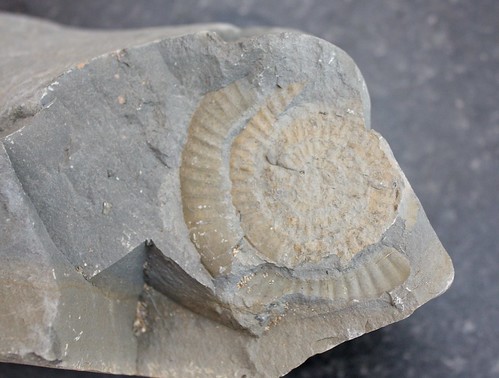I’ve been somewhat out of things for the last couple of weeks. I took some well-deserved vacation days and generally chilled out (even the presence of 350+ unread emails in my inbox when I got to work this morning didn’t spoil my mood) and even got away for a few days over New Year.
We met up with my parents and stayed in a cottage in Somerset, about a mile from the coast (and about 90 minutes drive from my favourite North Devon beach). We walked a bit, drank a bit, ate a lot. Had a really nice time, in fact.
We discovered a bamboo field. I guess it has to grow somewhere, but I envisaged somewhere more tropical—to be fair, after the past few weeks the climate did feel positively balmy.
We walked on the beach, a new experience for five month-old Rosie, but one she seemed to enjoy.
I marvelled at the revealed strata in the cliffs. I hypothesized that the rock underfoot was an ancient lava flow, and that countless long-dead sea creatures made up the layered slate above it, and that there must have been further volcanic flows followed by periods of relative calm (and dying sea creatures) in the 50+ million years of the Jurassic. I wondered what Henry would have made of it.
And, incredibly, just as I got down to the beach, I found a fossil.
‘Incredibly’, because I don’t find stuff like that. Not usually. The odd tuppence on the pavement maybe, but never something as awesomely cool as a creature that lived in the Jurassic. I picked it up, saying, “I’m having this.” I traced the outline of the fossil with my finger, realizing that it was rather the negative of a fossil; just an imprint in the rock.
Disappointed? Hardly. But as I looked around, I saw another fossil-bearing rock, lying not eighteen inches from the first. Picked it up. Traced the rock that once swam here. Turned it over and realized it fit the negative perfectly.
I thought about how the rock, as it fell from the cliff, had split in just the right place to reveal the fossil and its impression. Pondered that I was (probably) the first living being in 150 million years to see this creature.
Was—most likely—insufferably gobsmacked for the rest of the day.









How did you know it was from the Jurassic?
To be fair that’s a bit of a guess, but seeing as the leaflets we found in the cottage said it was a Jurassic beach I thought it was a reasonable one.
Wow!, is an ammonites. Is wonderful!!
Thanks Alejandro! It is wonderful, isn’t it?
Devonian comes from the English county of Devon!
Just googled the suckers (one of the other great things about the holiday was that it was almost impossible to get a mobile signal, and there was no internets at the cottage) and it appears they were extant from the Devonian (thanks Alejandro!) about 400 million years ago to the end of the cretinous, I mean Cretaceous, about 65 million years ago, nicely spanning the Jurassic.
You lucky, lucky bastard!
Are imposing and majestic the landscapes.
You’re really lucky, Richard.
That fossil rocks!
(sorry)
I’ve only ever found leaf imprints on North Yorkshire beaches – never anything from the animal kingdom. Very nicely done!
Lovely photos (yes I know I commented on one or two over at Flickr already). Sounds like a definite deep-breath, “aaaaaah” kind of break.
I like your ammonite but I’m even more puzzled by that bamboo. On the other hand, there are palm and monkey puzzle trees not far away on the south coast of Devon, so maybe I shouldn’t be quite so surprised.
Good to see you back. As a special prize, OT seemed to develop a gremlin while you were gone but you’ve obviously fixed it now. Happy New Year, by the way.
It was lovely, Alejandro, you should visit it sometime.
*laughs* @Cath.
Thanks ricardipus. And yes, I saw the gremlin. Figured out what it was, too, strangely.
Isn’t that how everyone finds fossils, just stumbles on them, maybe hits their toe on a protruding triceratops horn?
Seriously though, that is fantastic. I can’t imagine a more exciting thing.
Undoubtedly, Benoit!
I was amazed that I was lucky enough to find not just the fossil, but the lovely +ve and -ve thing he’s got going on there.
Kilve? Fantastic beach & great cream teas in summer! It’s Miscanthus for biofuel, not bamboo… Fab fossil, never found any when I walked there, but used to find bellamites (?) as a kid at Cromer
Kilve, yes! The pub (Hood Arms) is well worth it too, a super place. We had dinner there on New Year’s Eve, very good.
Miscanthus, you say? Looks like bamboo, though, up close?
(PS Jenny, now you mention it, it doesn’t look quite like the bamboo I’ve seen growing.)
Now I remembered this blog http://network.nature.com/groups/paleontology/forum/topics/4783
I put some photos of some landscapes of Amonnites in Chile in the the County of Lo Valdes
Are slightly different but equally beautiful landscapes.
That’s almost too perfect to be real! Reminds me of the street hawkers when I visited La Pas in the early 90s who would call out “fossil, fossil!” and pull their hands apart to reveal perfect positive/negative “rocks” bearing the fossil and imprint- just like yours!
Ooooh, that *is* lucky. I guess breaking where the fossil was makes sense though: that’s where the rock’s structure wasn’t as stable. But finding both halves – amazing!
Yup, it’s an ammonite. I doubt that there are lava flows here (their presence would have cooked the sedimentary rocks around), just layers of slate and sand, maybe, as the ocean rolled in and receded. But I don’t know that part of the world at all. Well done on finding the fossil – and especially the counterpart. We find fossil sea urchins from the Cretinous Period on Cromer beach fairly regularly. Crox Minor has a dozen or so in her Museum of Geology which we’ve found over the past four years. It’s amazing that what you have in your hand is the sign of a life that was lived kazillions of years ago. Innit.
I need a T-shirt that says “I went to Kilve beach and all I got was this lousy pebble.” And some really spectacularly gooey red clay on my boots.
Belemnites in Cromer! We find them in Cromer too, bu curiously in very isolated outcrops. There’s a reef I know that’s exposed at low tide that’s full of belemnite bits. Bellamites, on the other hand, are fans of rotund beardy botanists.
Alejandro, you’re calling me lucky after taking photos like that?
It was pretty amazing finding both halves. Next time I’m taking a hammer (and going in summer, when-hopefully-it won’t be so muddy).
Very nice! I’d be ridiculously happy to find something like that too – having spent hours as a child trying to find five-leaf clover, while all my mother and grandfather had to do was just to look down at their feet..
Steffi, I have never ever found a 4-leaf clover (let alone a 5-leaf), despite being told they’re actually relatively common. Maybe we should start a club?
I’ve just googled Kilve, and found out that the rocks are from the Lias – that is, the very earliest Jurassic, around 200 million years old – this makes it the same age as the cliffs at Lyme Regis in Dorset, famous for ammonites and remains of marine reptiles, and French Lieutenants’ Women. Apparently, one can find bits and pieces of marine reptiles at Kilve. But don’t take a hammer, Richard – Kilve is a Site of Special Scientific Interest (SSSI) and collecting is not allowed.
And also Mary Anning, yes?
Odd about the SSSI bit–I saw at least two people with hammers, and there were no notices anywhere about not collecting. I looked for such restrictions, too.
I don’t think anyone would mind your picking up fossils that are just hanging around loose. But have a care – this is our fossil heritage. How would a cell biologist like it if people just wandered into their labs and walked off with their cell cultures?
It’s called ‘citizen science’. The buggers would be welcome to some of the cultures I’ve grown, believe me.
Yes! RPG you’re benvinguts.
Believe it or not, this is a serious issue that concerns the palaeontology editor at your favourite weekly professional science magazine beginning with N. Now, the fossil heritage of Somerset is sufficiently well known that it is unlikely (though not impossible – they are still finding new dinosaurs in the Isle of Wight, for example) that you’ll walk off with something new to science qnd secrete it out of public view in your private collection, when it should properly be housed in a public museum where it is accessible to all. And that’s quite aside from the vandalism of digging holes and increasing erosion in a SSSI.
However, many exposures that produce fossils of great scientific importance, and in which I am interested professionally, as an editor, are mined commercially for their fossils – I am thinking of parts of Morocco (known for its trilobites and, more recently, remarkable late occurrences of Burgess-Shales type faunas); the Santana formation of Northeast Brazil (known for its remarkable pterosaurs) and the Liaoning Beds of Northeast China (known mainly for feathered dinosaurs). Some specimens that come to my attention have been brought to scientists’ attention by dealers, rather than being collected in situ. This raises the spectre of forgery, and also makes it hard in many cases to know precisely whence the fossils came – vital for dating, understanding palaeoecology and so on.
But such matters aren’t just problems of far countries of which, as Chamberlain said of Czechoslovakia, we know little. As I said, new dinosaurs are still being discovered in fair Albion. And just a few miles from the Maison Des Girrafes is the SSSI at West Runton, where amazing Ice-Age foasils, including a whole mammoth, have been discovered. It’s not for nothing that palaeontologists get friendly with local collectors who know what they are looking for and have appropriate respect for the material. But Joe Public who turns up at such a site with a hammer and engages in some illicit quarrying is not a pretty sight and should not be encouraged.
For sure–and perhaps I won’t take a hammer next time. But I reiterate that not only did I see members of (what I assumed to be) public wandering around with hammers, but there was no notification either on the approach to the beach, the beach itself, nor in the local touristy leaflets.
Put these deficiencies down to local ignorance not least on the part of local authorities, some of whom wouldn’t know a SSSI if you hit them over the head with it. But even if there were notices, people would ignore them. On Cromer beach there are notices promising beheading or worse for anyone who takes even one pebble off the beach – and yet we all do it, even me. However, there is a difference between taking an interesting fossil home and digging out the whole cliff.
Is true only observe, in Chile there is no control over it.
People (cretinous) sell fossils!
Dig out the cliff at Kilve and it would fall on you.
and it would serve you right.
At least I’d have a hammer to dig my way out.
I myself am in possession of two rather nice fossilized sea urchins that I believe originated in a quarry in St. Albans. Somewhere or other I posted a pic of them (possibly on Henry’s NN blog… I’m too lazy to go digging to try and find it though. The photo is here if you’re interested.
As for hammers, it is well established that they are best used for killing rare foxes. Although the way this discussion is going, I’m thinking that an rpg vs. Henry duel at 20 paces might be considered, too. 😉
“I’d rather be a hammer than a snail…”
(Sorry, r’pus; you were in moderation for some reason)
Nice urchins. And Henry is a wimp. I can take him with my left hand (as long as he doesn’t play to form and cheat, of course).
@Steve *groan*
Bollocks. But I would say that, wouldn’t I?
Re an RPG vs Henry showdown, doesn’t RPG have an unfair advantage?
Unless we equip Henry with some equally serious hardware… perhaps an AK?
Awesome! It must been quite a thing there Richard.
I remember the first fossil I found, on the beaches of Fårö (ittle island north of Gotland, another island east of Sweden 😉 ) Funny enough though, it is still there… much to my sadness as a child…. SSSI (thanks for the English acronym Henry) in hard effect on the whole island. And my mother was very dilligent of telling us all not to bring any home. I know some people still take some rocks but in general they are left alone for others to come looking at them.
I wish I had some nice photos at Flickr of the ‘raukar’ but sadly I think this was pre-digital camera… old and long time ago 🙂
Aw, you’re making me all wet with nostalgia, now.
Quiet, Henry.
someone say something?
Did you see this?
Someone (not me) should blog it. Henry?
ooh. Nice find.
been there. Done that.
Hi all! Just landed here as I have a google alert for ‘fossil’ – handy when my day job is director of the Lyme Regis Fossil Festival… Lovely ammonite, and don’t feel even remotely guilty about picking it up and taking it home. Anything that is on the beach around these parts is going to be smashed by the waves and tides very very quickly, and if you don’t pick it up and take it home it will be just be dust and mud very soon, and the fishes really won’t appreciate it the way you will. The hammering and digging rules will vary from place to place (although never ever pick at or dig into or up against the Jurassic Coast cliffs unless you want to die under a landslip). Here’s the Jurassic Coast’s fossil collecting code which will give you some guidelines: http://bit.ly/fOhfqn You can find loads of fabulous things without ever touching a hammer, but if you want to have a go book a walk with one of the local guides in Charmouth or Lyme and they will teach you how to use it properly and what kinds of rocks to look for. No point wasting your time, accidentally smashing your ammo inside the rock to bits, or getting a shard in your eye… The Jurassic Coast got its UNESCO designation (England’s only Natural World Heritage Site) precisely because the cliffs and constantly eroding and exposing new fossils and geology, and there are new and scientifically important things being found all the time (see http://bit.ly/elFAqP and http://bit.ly/cNQkba for example) – but if no one picks them up they are gone forever. As part of the Festival this year (29 April to 1 May – new website will be ready in a week or two) we are having an exhibition ‘Secret Stones’ of some of the best of the local collectors’ finds – some have never been exhibited in public before, and many are ‘type’ specimens. If you find anything that you can’t identify bring it to the Festival – last year we had 35 scientists from the Natural History Museum with us, along with all the local collectors, so you’ll have no trouble finding someone to tell you all you’ll ever want to know about your rock. And yes, you can buy fossils here too, but all the scientifically important ones are registered at the Charmouth Heritage Coast Centre. And if you really want to find more fossils don’t wait until the summertime – that’s the worst time for collecting. Winter gales and big waves are what makes the fossil collectors’ hearts sing… a few weeks ago one of my friends found an ammo that is more than a foot across on the beach a few minutes away from the centre of Lyme – we’ve been watching it for more than a year (it was about 50 feet up and sticking out of the cliff) and he was just very very lucky – that he was there just after the cliff slipped, that he knew to look for it, and that it didn’t break into lots of pieces when it fell.
Happy hunting!
Kimberly
Wow.
Thanks for all that, Kimberley. There are indeed some useful guidelines at your first link. They seem horribly sensible!